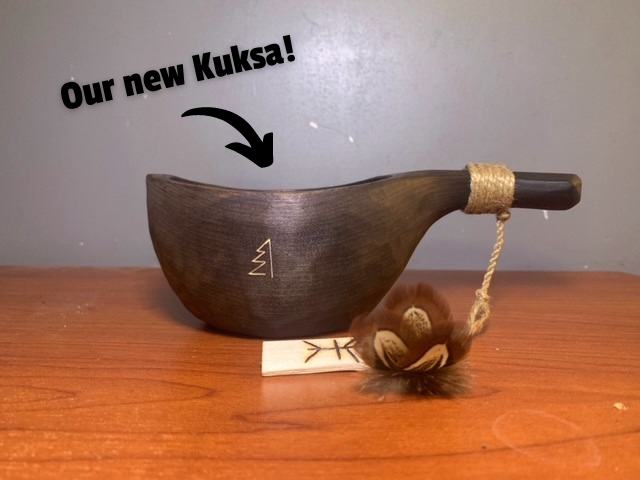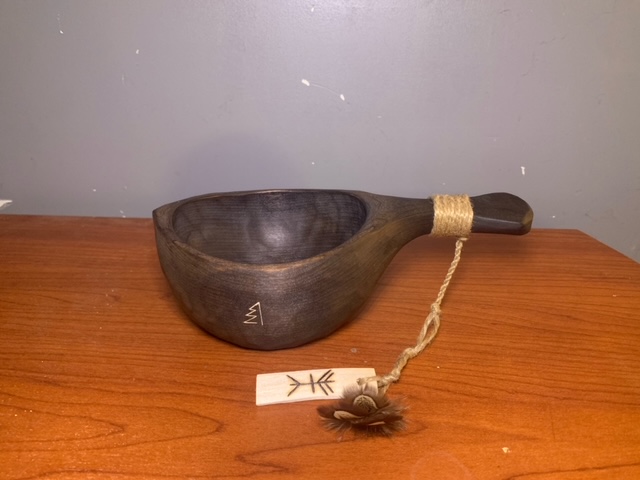
Today is an exciting day! Before we get too far into learning about kuksas, we would first like to say happy holidays to everyone who has found the blog and has started to follow. We are so grateful for your time and connecting with each of you through our experiences and stories, is a wonderful feeling. Thank you!
Living in the cold, harsh climate of Manitoba means that we often have to consider different tools while in the bush. The old, stainless steel canteens are a bleeding lip waiting to happen. You only ever lick a steel pole in the wintertime once in Canada, and you never forget it. For this reason, a wooden Kuksa, is the cold-approved drinking utensil for the great white North!
Today is the day we got to unbox ours!

What is a kuksa?
Kuksa is the Finnish translation for a Guksi, a wooden cup traditionally made by the Sami people. Here is an excerpt from Kotka Living:
Originally, kuksa were widely used in Arctic areas as a personal drinking cup, so they had to be durable. The kuksas come from the Duodji: a handicraft of the Sami people. The duodji is functional and utilitarian, and sometimes concerns artistic elements but essentially are everyday objects (knives, bowls etc.) This art form splits into two categories because of the materials used – all of them natural: female objects, most often made of skins, and male objects made of wood, horn or bone. They are linked to the nomadic way of life: they had to be practical while remaining easy to adapt to the constraints linked to the environment.
Kuksa made of burl holds cold or warm drinks and can be used for collecting berries. Birch burl can withstand big temperature differences, and because of this it’s no problem to pour boiling water while the air temperature is freezing -15°C. The material does not crack when dropped on the ground. The name Guksi or Kuksa means ladle, a cup or a scoop, as that is what it was used for.
The kuksa is part of the male object group. It was traditionally handmade, requiring both time and dexterity in the cutting of the wood. In most cases, a Sámi would make his own kuksa. It was also meant to be a gift sometimes. The kuksa embodies the duodji’s importance in Sámi identity: a handmade object which bears a culture, a symbol of their way of life.
The Story of kuksa – kotka living
How is a kuksa made?
Birch is an ideal kuksa wood and is historically the most common wood used for this purpose. The most prized kuksa wood is a birch burl that has the same curvature as the finished kuksa, but other woods can be used as well. A burl is a tree growth in which the grain has grown in a deformed manner. Burl formation is typically a result of some form of stress such as an injury or a viral or fungal infection. It often takes the shape of a knot or rounded outgrowth and looks a lot like the Chaga we talked about in our last post!

What kuksa did we get?
We picked up a kuksa made from Anton in Western Siberia. He runs https://soul-of-siberia.ru/ “Soul of Siberia” kuksa shop. You can watch him work below:
What do we think?
It is absolutely beautiful! It’s light, yet sturdy and the wood grain gives it its own unique fingerprint and story. This is something we have always loved about wood carving and using wood as a raw material. In fact, we love it so much, our engagement ring from Chasing Victory, has a Bethlehem olive wood inlay, but that is another story for another day. We also feel like after that harvest of Chaga last month and now this birch kuksa, that we are somehow connected to the birch trees this winter – just an interesting observation.
Our official opinion is that they are a must-have for the avid outdoors-person!
